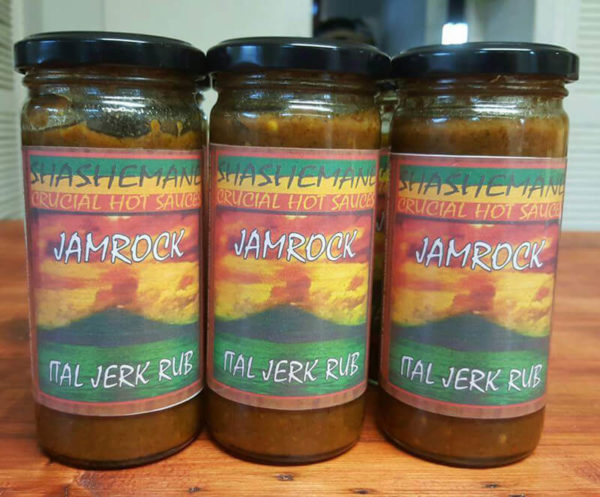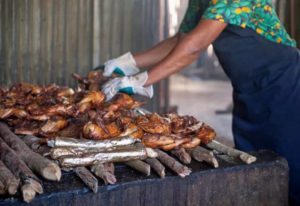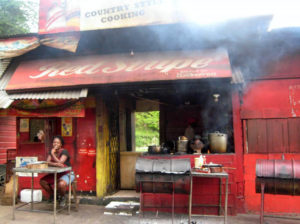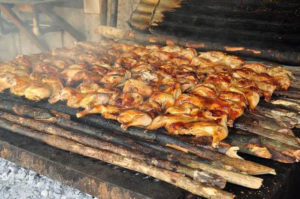
30 May Andrew’s Essential Fiery Food Facts that a Pyro-Gourmaniac needs to Know Part 22
Andrew’s Essential Fiery Food Facts that a Pyro-Gourmaniac needs to Know
Part 22
The Art of Jamaican Jerk Cooking.
This has been a long time favourite of mine, for over 24 years I have used Jerk Rubs and Spice blends, serving , Jerked Swordfish , Jerked Chicken and Jerked Tofu at our old Restaurant Shashemane when we operated at Cabarita Beach. The Heat , the herbs and unique spices make this one of the best Blends for Barbecuing …
But what is it you ask….
Jerk refers to a way that a meat, whether it be chicken, beef, pork, goat, fish, vegetables or fruit is seasoned and cooked. This style comes from Jamaica. The typical cooking style uses a marinade or paste that includes at least pimento, which is often called allspice, and Scotch Bonnet chillies, or alternatively Habenero. The meat is then marinated and slow smoked over pimento wood. Pimentia o pimento is a Spanish word for pepper and early European explorers mistook this for black pepper, so they called it pimento.
Like most Caribbean islands, Jamaican foods are derived from many different settlement cultures, including British, Dutch, French, Spanish, East Indian, West African, Portuguese, and Chinese.
The origins of jerk pork can be traced back to the pre-slavery days of the Cormantee hunters of West Africa through the Maroons, who were Jamaican slaves that escaped from the British during the invasion of 1655.
According to most food history authorities, jerk is a Spanish word that comes via the Peruvian word charqui, a word for dried strips of meat like what we call Jerky, in much of the world. The word started as a noun and then became a verb as in “Jerking” which meant to poke holes in the meat so the spices could permeate the meat. Jerk cooking experts like native Jamaican and author Helen Willinsky of “Jerk from Jamaica” fame says that the name Jerk also could have come from the turning of the meat in the marinade or from the way some folks will just jerk a strip from the roast on the BBQ. We just don’t know.
Most historians agree Jamaica was settled by the Arawak Indians over 2500 years ago from South America. They used similar techniques to smoke and dry meat in the sun or over a slow fire, that were common in Peru. This was important as the dried beef could be taken on journeys and eaten as is or chopped and reconstituted in boiling water. This ancient technique goes on today and is known as jerky.
In 1492 Columbus claimed it for Spain and enslaved the Arawak Indians. Soon they died and were replaced by African slaves.
In the 1700’s some of the slaves escaped and hid in the Blue Mountains of Jamaica and became known as Maroons, they had to keep watch closely to evade the British army from recapture.
With food in short supply the learned to catch wild boars in the forest. Using salt, peppers and spices they learned to preserve the meat. They knew not when their next kill would be. The Maroons would blend an array of spices and herbs that they would later use to marinate and cook the wild game they hunted. This led to the invention of the now famous “Jamaican Jerk”. American writer and anthropologist Zora Neale Hurston once recounted an overnight boar hunt with the Maroons in 1939: “Towards morning we ate our fill of jerk pork. It is better than our American barbecue. It is hard to imagine anything better than pork the way the Maroons jerk it.” The Maroons dug holes in the ground, filled them with charcoal, the meat was spiced and wrapped in leaves to keep. When it came time to cook it they just placed it all in with hot rocks then covered or it was Barbecued over a lattice of wood ,which they then covered so as not to produce smoke and attract the attention of those that would bring them back into slavery.
This evolved with the use of different spices to the cooking style that we know today as Jerk. Ask a Jamaican what the word “jerk” means they they’ll tell you it refers to the motion in either turning the meat over burning coal or in chopping off the hunks of meat for customers. The explanation refers to the English form of a Spanish word of Indian origin that described a method of preparing pork. That method was then modified and then preserved by the Maroons.
Jerk cuisine is a combination of culture, authentic flavours and slow cooking. Though the slow-smoke method is an age-old Caribbean practice used to cure meat, by marinating or rubbing meats, seafood, and even vegetables with the right seasonings and then slow grilling them over wood, jerked foods take on a spicy-sweet flavour and tender texture that’s unmatched. Famous for its fiery hot mixture centred around the Scotch bonnet chili pepper, considered one of the world’s hottest, jerk is like a carnival of flavours that come together in your mouth.
Though traditionally cooked in open-ground pits, today jerk cooking tends to be done in half-cut steel drums, turned into makeshift grills, now commonly called Jerk Pits. On any given street corner throughout Jamaica, you will find vendors hovering over smoky fires in jerk huts, slow cooking their uniquely flavoured delicacies.
When one thinks of Jamaica a few things come to mind, white sandy beaches, Reggae music, and Jamaican Jerk
The spices, the colourful flavours, the smoky aroma…. the taste of Jamaican Jerk cooking is memorable. Traditional Jamaican Jerk is a method of cooking pork. Nowadays chicken, seafood or beef can be seasoned in this manner as well. Jerk is a complex blend of seasonings including Spring Onions, Chives, Onions, Scotch bonnet Chillies, Salt, thyme, Allspice, Black pepper and other spices. All of its ingredients were grown on the island’s fertile green landscape.
Jerk Huts are all over the Caribbean Islands, and you can find them by the lovely smell.
Many times they are shacks that are octagonal or circular built around a telephone pole to support the thatched roof. Dining is outside, as well as the cooking of the food. The legendary mecca for Jerk is Boston Beach on the north eastern end of Jamaica. The smell of alluring fragrances of grilled pork, chicken, fish and beef fills the air . Here most of the vendors have built huts over fires directly on the beach like the Maroons that came before them. The meat is cooked on pimento wood or sheets of metal used as grill plates and sometimes covered with plantain leaves.
If you would like to experience the taste of Jamaican Jerk, why not try the original “Shashemane Exotic Spice Blends – Jamrock Ital jerk Rub” available online in Australia..
https://www.facebook.com/Shashemane-Exotic-Spice-Blends-1302624503210583/
Jamaican Jerk is considered a national treasure in Jamaica . Many have attempted to imitate its unique flavour, but none can come even close to replicating it, that’s why we use an authentic Jamaican recipe. Much like Reggae music, it is not only something that is distinctly Jamaican, but also an expression of harmony, pride and rich cultural history.
Jerk chicken is the most well-known Jamaican dish to have been exported from the island. Long before jerk chicken even hits that elaborate grill setup, it’s soaked in a simple to make but complex-tasting marinade that gives the meat its sweet and spicy flavour. You know what I’m talking about, moist pieces of poultry that are full of soaked-up marinade flavour, with burnished skin and crispy, blackened bits of meat courtesy of the grill the bird is cooked on.
But if you’ve never had the chance to visit the tiny nation that jerk chicken hails from, then you’ve never really had the authentic dish. Here’s why, true jerk chicken is cooked not just over coals, but also over fresh green wood: most traditionally, wood from the pimento tree, which is native to the Caribbean and produces another very important jerk chicken ingredient—allspice berries, used in the marinade—or sometimes sweetwood, the Jamaican name for the Bay laurel tree.
In Jamaica, the wood of these trees is essential to the jerk process. To cook the chicken , or the pork, also widely available at jerk joints, it all starts with the wood, which, in the form of charcoals, is laid under huge metal grates and continually stoked to stay roaring hot. Then, big logs of pimento or allspice wood are laid on top of the grates. The meat is placed directly on top of the green wood, then covered with big sheets of metal. Well-made, authentic jerk chicken is addictive: It’s both smoky and moist, sweet and spicy. The long marination and long cooking time leave it soft and tender.
As the chicken cooks, it absorbs oils directly from the surface of the wood, and also gets imbued with the fragrant steam and smoke produced by the green wood and the charcoals underneath. Once the chicken is cooked, which usually takes about two hours for a butterflied chicken turned once— it’s removed from the grill, stripped from the bone, and chopped up, all the better to expose it to fiery-hot Scotch bonnet Chilli traditionally served on the side. Fiery, vinegary Scotch bonnet Chilli sauce, is always on hand to be eaten with jerk chicken or pork , and the hot chilli sauce cuts through the richness of the meat and keeps you going back for more
What’s in Jerk chicken marinade.
In Jamaica, the jerk chicken joints are invariably reluctant to share exactly what goes into their house marinades, but there’s an agreed-upon formula that forms the base of the marinade, which individual cooks or restaurants will riff on, changing an ingredient here, adding another one there. The formula includes these ingredients:
Allspice berries. The fruit of the pimento tree used for grilling jerk chicken, allspice berries are dried and resemble peppercorns. They have a sweet, spicy, floral flavour, and got their name when English settlers of the Caribbean tasted them and thought they combined the flavours of cinnamon, nutmeg, and cloves. The berries are ground to release their essential oils.
Thyme. Fresh is preferable, but dried is also used.
Scotch bonnet Chilli. Native to the Caribbean, Scotch bonnet Chillies are extremely spicy, about 40 times hotter than jalapenos. The Chillies are chopped or blended for use in the marinade, and seeds can be left in or removed for less heat.
Chives or Spring onions. Both white and green parts, chopped.
Fresh ginger. Peeled and grated. The ginger plant flourishes in the Caribbean, and is used in many regional specialities such as ginger beer and sorrel, a drink that’s brewed from hibiscus flowers.
And that’s it. Other common ingredients added to this base include ground cinnamon or nutmeg, brown or white sugar, vegetable oil, or soy sauce. Most cooks marinate their meat for as long as possible, at least 12 hours but sometimes up to 24. As a result, the chicken is imbued with a ton of flavour before it even meets the coals and wood that will fill it with smokiness.
Whatever the recipe used, Jamaicans have a fierce passion for this native dish that’s as treasured for its historical significance as it is for its sheer tastiness.







